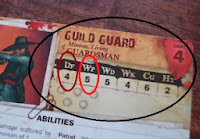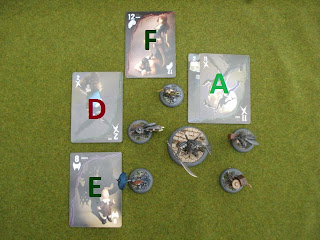Editors Note - This tutorial is for version 1.5 of the Malifaux rules and has been left available for reference only. Some Malifaux 2nd Edition Tutorials can be found here...as well as quite a few of these old ones, lol.
As well as Masters and Minions, another group known as Henchmen also exists.
Henchmen can be used either as normal(ish) Minions or as
Masters in their own right. They're not quite as flexible as
Masters however as they have some limitations.
If a character is capable of being used as a Henchman they will have the Henchman rule in the characteristics section like so,
This is the Stat card of Molly Squidpiddge who is a
Henchman. The number after the
Henchman characteristic (called the
Henchman Reserve) affects her in certain ways that we'll come to later. Each
Henchman will also have reference to a
Special Forces type which in her case is Horrors. The model still has a Soulstone cost (9 in this case) which will be used should she not be the
Master. Sometimes the
Special Force will cover more than one model type...if so it will say so on the card. Molly (for example) can also hire models with the 'Belle' type as Horrors.
This card belongs to another
Henchman model called Collodi. Like Molly above he has the
Henchman characteristic followed by a number and a
Special Forces type (Dolls). Also like Molly he has a Soulstone cost for when he's not being used as a
Master.
Now you know what your looking for, lets look at some common traits that apply to all models with the
Henchman model type. Firstly,
Henchmen all have the
Use Soulstone Ability whether it's listed on their card or not. Secondly, a crew containing a Henchman is no longer limited to the two model hiring limit on Special Forces...
Normally if a model is part of a Special Force (Horrors, Dolls, etc) a crew can only hire two of them and those two must be from the same Special Force. If however your crew contains a Henchman then this limit is lifted and you may hire as many as you can afford...you can still only hire from one Special Force though.
Finally if the crew is being led by one or more Masters you can only hire one Henchman per Master.
An Example.
Seamus, the Mad Hatter would like to hire two Crooligans and a Rogue Necromancy as well as a few Rotten Belles and a couple of Punk Zombies. Unfortunately the Crooligans and the Rogue Necromancy are all Horrors and he is limited to two
Special Force models so he couldn't hire all three...
The player decides instead to use Molly Squidpiddge as his
Master. Because she has
Special Forces (Horrors) on her stat card the two model limit no longer applies so she can take both the Crooligans and the Rogue Necromancy and because her card specifically says so, she can also take the Belles...unfortunately she can't take the Punk Zombies as they are neither Horrors or Belles...
This time the player takes Seamus, the Mad Hatter as his
Master but also takes Molly Squidpiddge. This time he can take all the Horrors he wishes as Molly has the
Special Forces (Horrors) rule and Seamus can take everything else because they're all legitimate choices for him and both him and Molly can take Belles...success at last...
With that out of the way, lets look at the two different possibilities. Either the Henchman is part of a crew or leading a crew...
Leading a Crew.
We'll use Collodi as an example.
1) When leading a crew the
Henchman's Soulstone Cost becomes 0. So Collodi wouldn't cost you 8 Soulstones (
circled in red) he'd cost 0 just like a
Master would do.
2) Every
Henchman has what is referred to as a '
Henchman Reserve' which is the number after the
Henchman characteristic (
circled in green). This amount is added to the amount of Soulstones that you can use to purchase your crew. So (for example) in a 25 Soulstone game, Collodi would have 32 (25 plus his
Henchman Reserve of 7) Soulstones to spend.
3) As mentioned previously the
Special Forces hiring limit of 2 is ignored when using a
Henchman as a
Master and the particular
Special Force that they can hire from will be listed. In Collodi's case he can only include models that are from the 'Dolls'
Special Force (
circled in purple).
4) The
Henchman can connect a Totem just like a
Master could with the same limitations. So Collodi could connect a Neverborn Totem (like Primordial Magic) but not one that is specific to a particular
Master (such as Poltergeist or Malifaux Cherub).
5) The
Soulstone Pool for the Crew is determined as normal with two limitations. Firstly a
Henchman used as a
Master has a starting Soulstone Cache of 0 and secondly that Soulstone Cache cannot be higher than their
Henchman Reserve (
circled in green). So Collodi couldn't start with a
Soulstone Pool of more than 7, Molly would be limited to 5, etc. even if they would be entitled to more.
6) As the
Henchman is effectively a
Master when leading a crew they are affected by anything that would affect a
Master regardless of whether that's a good or a bad thing. So for the purposes of Strategies and Schemes they're a
Master and if an ability, spell or whatever states that it can't be used on a
Master then they're immune to it just like a 'normal'
Master. So (for example) if Collodi was leading a Crew he would be immune to the 'Obey' Spell.
Henchman in a Master's Crew.
We'll use Von Schill as our example this time.
1) The
Henchman's Soulstone cost (
circled in red) must be paid as normal so in this case Von Schill would cost 9 Soulstones. If he was being used as a
Master he'd cost 0.
2) The Henchman Reserve (
circled in green) is ignored completely.
3) The
Henchman can connect a Totem just like a
Master could with the same limitations. So Von Schill could connect an Outcast Totem (like Student of Conflict) but not one that is specific to a particular
Master (such as Giant Mosquito).
4) As mentioned previously the
Special Forces hiring limit of 2 is ignored when using a
Henchman and the particular
Special Force that they can hire from will be listed. In Von Schill's case he can only include models that are from the 'Freikorps'
Special Force (
circled in purple).
5) A
Henchman hired into a
Master led Crew counts as a
Henchman for the purposes of Strategies and Schemes.
So that should be all you need to know about Henchmen...hopefully...
If you have any questions or find any errors with this tutorial then feel free to leave them in the comments section below.

+-+Circled.JPG)
.JPG)
.JPG)






















.JPG)



.JPG)
.JPG)
.JPG)













.JPG)

+Leveticus.JPG)
+A+Hollow+Waif+is+Summoned.JPG)
+Eternally+Shackled.JPG)
+Leveticus+is+Dead...For+Now.JPG)
+Leveticus+is+Back.JPG)
+Last+Waif+Sacrificed.JPG)
+The+Hollow+Waifs+Return.JPG)